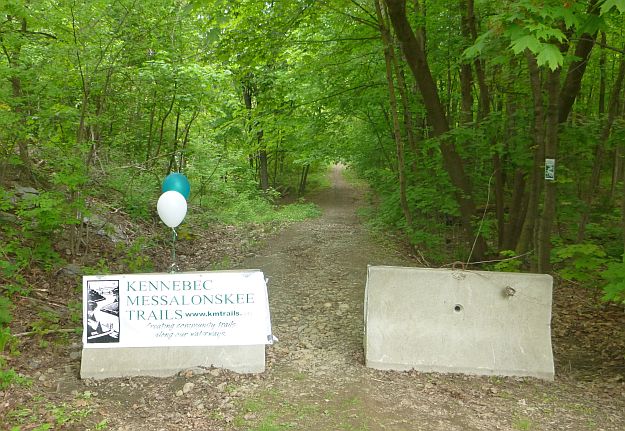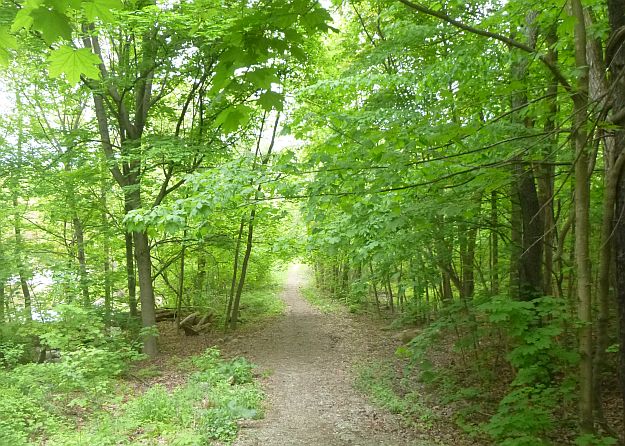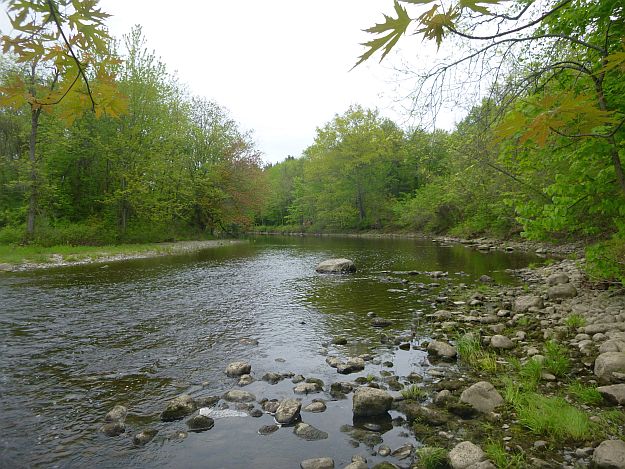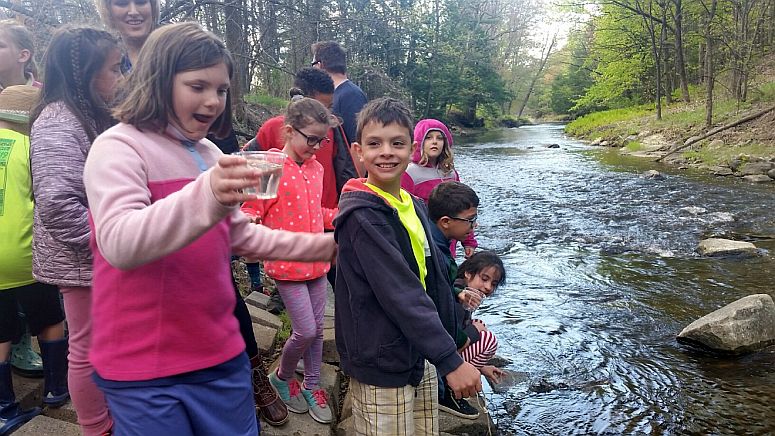
Readfield Elementary students stock Atlantic salmon in Bond Brook in Augusta. More…
Highlights from this issue…
- Twenty-Five Years Ago: Oh, What a Time of Change
- The Oxbow: A Photo Essay
- Invasives: The Plant Variety
- "The Grandkids are Coming, The Grandkids are Coming!"
- Pond Levels Spot On
- What To Do With a Dead Loon
- The Popham Colony
- Hiking Again
Download Full Print Edition [PDF] • Links to Other Pages on This Site
These archival articles are presented “as is.” Except for minor corrections or clarifications, most have not been updated since they appeared in print. Thus, some details may be out of date, and some hyperlinks may no longer work.
Twenty-Five Years Ago: Oh, What a Time of Change
The season of 1994 was a pivotal summer for the region, for the Belgrade chain of lakes, for central Maine and for the century-old tourism trend of rustic camps, small seasonal businesses and relaxed resort lifestyles.
In the summer of 1994 many were the beginnings of change that have carried over into today, that have resulted in more appreciation of the natural and economic resources of the area, more attention to the required stewardship of the region and more acknowledgement of the emerging importance of regional links.
Being linked together by a chain of lakes, which is where it all begins, is no small responsibility and the link of the lakes solidified a lot during the summer of 1994. It prompted the expansion of social activities and environmental concerns. It prompted an acceleration of education and information about all the lakes, all the towns, all the properties. And it prompted a resurgence of lake associations and a revival of those long in place.
The mantra in 1994 was do go near the water, do so safely. It wasn't unusual to see the Central Maine Association of Rescue Divers practicing off Peninsula Park in Belgrade Lakes which offered good water clarity and depth and rough rapids from the dam to simulate river rescues. Among the divers, the Kennebec County Sheriffs had one of the most active and dedicated diving units in the state, with 12 divers part of the department staff.
Going near, getting into, caring for the lakes was especially called into play by Lake Week '94: the annual celebration of Maine's lakes — a time to educate, publicize, promote through lake awareness activities. Started in 1988 with assistance and funding from the Maine Department of Environmental Protection, Lakeweek in 1993 was taken over by the Congress of Lake Associations — COLA (now known as the Maine Lakes Society) but was implemented uniquely by each lake association's clean-up and appreciation endeavors such as the No-Octane Regatta, Anything- But-Fish Derby, Wildlife Paddle and decorated boat parade.
The highlight of Lake Week '94 was the COLA conference at Colby College in Waterville and the highlight of the conference for Belgraders may have been the pronouncement by director of China Lake's remediation, George Lord, that Great Pond would be next to turn green, a pronouncement that would become the watershed's catalyst to proactivity year round.
Year-roundness became one of the biggest changes that can be credited to the developments of 1994: year round meetings and newsletters, expanded memberships, getting all the lake associations to work together. Indeed, the first combined meeting of all the lake associations of the Belgrades was held that September to explore alliance alternatives which soon led to the establishment of the Belgrade youth conservation corps, to a strong relationship with Colby College — which was invited to use upper Long Pond as a classroom that fall and to the eventual preparedness for other challenges the lakes continue to meet.
It wasn't all lake news in the summer of 1994. Indeed Maine Farm Days, basically a trade show for farmers, which was held at the Rowbottom Family farm in Norridgewock almost had a crowd control situation due to the unanticipated attendance of nonfarmer folks who rode the wagons, took the tours, ate the ice cream and loved the whole experience.
By summer's end, one trend was certain: 1994 was a golden era for volunteerism. The information building on Route 27 on the southern approach to Belgrade was open daily, staffed by volunteers and their ideas, material, labor and time (especially time) were all part of their contribution to promoting the vacation experience to passersby and welcoming visitors from six other countries and eighteen other states.
By summer's end there was also, well … the promise of controversial construction in downtown Belgrade Lakes. After 70 years, it was time for a new bridge across the Belgrade Stream (a.k.a. The Channel) and even though the Maine Department of Transportation assured the anglers in the community that the dam area would be open in time for fishing many other residents had serious concerns. Would spectators still be able to line the bridge to listen to the annual loon calling contest. Would pedestrians still have their scenic sidewalk on the Long Pond side. And, what about parking?? Four spaces, it was rumored, would be lost.
As they say, the more things change, the more they remain the same.
▲ To Table of Contents • Print Article • To Other Links ▼
The Oxbow: A Photo Essay
Photos and Text by Gregor Smith
Created more than four decades ago, the Oxbow Nature Trail is one of Waterville's oldest trails. The easy, three-quarter-of-a-mile loop sits on an undeveloped, 19-acre parcel at a U-shaped bend, or oxbow, on the Messalonskee Stream. The land is owned mainly by the Lutheran Church of the Resurrection, with the lowlands belonging to the Maine Children's Home for Little Wanderers, whose campus is across the stream on Silver Street. The trailhead is just north of the church's parking lot on Cool Street.
These photos were taken on June 1, National Trails Day, after a clean-up in which volunteers from Kennebec Messalonskee Trails picked up litter and removed invasive plants. National Trails Day is celebrated each year throughout the United States on the first Saturday in June.
▲ To Table of Contents • Print Article • To Other Links ▼
Invasives: The Plant Variety
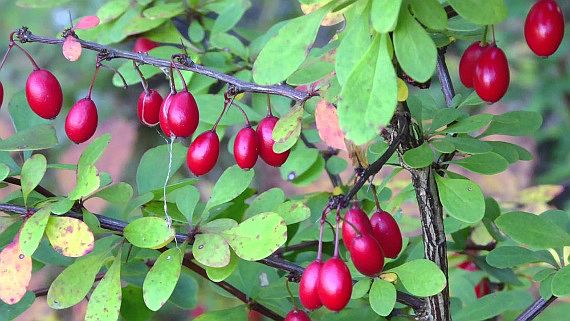
Japanese Barberry
I missed week one of Summertime in the Belgrades. So, I'll launch right into the first topic for the season: invasive plants. While plant life seems to be getting a later start this season, now is the time to begin identifying any "invasives" and try and mitigate their spread.
An invasive plant is defined as a plant that
- Is not native to a particular ecosystem/area,
- Can cause economic or environmental harm or harm to human health, and
- Can establish and spread in natural areas.
About one third of Maine's roughly 2,100 plant species are not native. According to the Maine Natural Areas Program website: "Of those plants that are not native, only a small fraction are considered invasive, but these have the potential to cause great harm to our landscape."
Check the Maine Natural Areas Program list of fact sheets to determine if a particular species is considered invasive in Maine. The MNAP is the go-to state agency in Maine for answering questions and getting information about invasive plants.
There is also a generic state website for all types of invasives, i.e. animals, forest pests, aquatic plants, and terrestrial plants. These websites have "gallery views" available, which provide good photos to use in identification.
There is a good terrestrial and wetland Maine Invasive Plant Field Guide, written in 2019. It is a handy 3¾″ × 8″, 46-page field guide mounted on rings in a binder so that it is easy to flip through and can be added to. The price is $24.95, plus tax and shipping.
Here in the local area we need to come to grips with the invasive plants that are doing damage to our natural areas and native plants. Japanese barberry, multiflora rose, and autumn olive seem particularly robust. Asiatic bittersweet vine — see picture above in Oxbow article — and common buckthorn are also appearing more frequently. Japanese knotweed often gets established at a construction site or as we do landscaping. At this time of year, garlic mustard appears at the wood's edge. Your back yards are feeling the pressure of these invasive plants. There is a list of these invasive plants with names and pictures. Check the Maine Lakes Resource Center in Belgrade Lakes Village, the University of Maine Cooperative Extension, or our office and pick up some of the handouts.
The first line of defense is to accurately identify the plant. Usually trying to control their spread is the only choice. They will eventually appear. That's where the Field Guide comes in handy.
Recognize that there is a problem. That occasional plant out back with interesting foliage and a pretty flower might become a thick bank of vegetation if you leave it be. Look along the edge of the woods on your property and note the occasional spring clusters of white flowers which indicate multiflora rose. Next year that small patch of white flowers will be joined by additional mounds of nasty thorn covered plants. At that point removal is much more difficult. That area can become a breeding ground of fruit and seeds which get spread to neighboring properties.
Our natural landscape is part of what Maine is all about. Its future depends on the choices we make. When buying plants or moving them from place to place, consider whether the plants are likely to spread. Plants advertised as fast growing, prolific, and soil tolerant are often the ones that become invasive. Maine just won't be Maine if the plants dominating our landscape are all from away.
- When buying plants for your yard, select native plants.
- Replace invasive plants in your garden with non-invasive alternatives.
- DO NOT attack the problem with indiscriminant herbicide use. They may have a place in your management plan but they are NOT a magic bullet.
- Check out the Maine Natural Areas IMapInvasive program and become a citizen scientist.
Managing invasive plants in the landscape is part of our effort to protect our Maine landscape. While we may talk about managing our tourists, the other "invasives," those people usually leave in the fall, and we frequently benefit from their visit. Not so with the invasive plants!
Now retired, Dale Finseth was executive director of the Kennebec County Soil & Water Conservation District from 2001 to 2024. This article was updated April 2021.
▲ To Table of Contents • Print Article • To Other Links ▼
"The Grandkids are Coming, The Grandkids are Coming!"
This may not be as earth shattering as Paul Revere's warning announcement in 1776, but ask any grandparent what the highlight of their year or season is and the answer is the pretty much the same. After asking several Grammies and Grampies, here are some replies: "Oh, it has to be when the kids come on the Fourth of July"; "Definitely when the grands come for Christmas"; "Whenever we see the kids either at their house or ours."
In contemplating this story I realize that what brought on the notion to use this topic is that our own children and grands are coming to visit during the Fourth of July period. There's much talk about it between Doris and me and we realize that the kids are chatting amongst themselves and making their own plans, too.
We hear tidbits from our children that the grands are now either talking or texting back and forth. Their concerns are who might come, who's going to bunk with whom, who can drive the boat this year, who might make it up on water skis and so on. The excitement is growing for all three generations in different ways.
As the weeks and months plod along, school gets closer to being over and the summer dreams will soon become a reality. Plans are finalized for each generation. Gram and Gramp have seen to it that the seasonal cottage or home is ready for the ever expanding family. The docks are in, the boats are serviced and sitting idle at their moorings — quietly awaiting their young captains. Mom and Dad have had their own hands full with the juggling of schedules, job time off, travel arrangements, finances and much more. The grandkids have somewhat settled on who is sleeping where, what friend might come for a couple of days, and who got the long straw on driving the boat first.
The elders, having seen this whole process happen before with their own children, sit back with satisfaction and take it all in. They know that every year is special, not just for them but everyone involved. They know that each visit is unique yet can be similar. They know that their children and grandchildren will be enriched and their horizons broadened during these special times. They know that many life-long friendships may be made, alliances formed and new loves experienced.
In many small Maine inland communities, our case being the Belgrade Area and its chain of lakes, we usually frame our thinking about family summer visits being at the lakeside camp or home. This may be the case with us, but we also know that Maine has a large coastal summer influx of visitors that are drawn to the ocean. In our northern wilderness areas upland rivers and mountains abound, offering peace and serenity to others.
Whatever your family chooses as an annual gathering place, where bonding is developed and memories are made, do your best to advocate and continue it. I truly believe that what a person gains from these annual visits to their special place is worth it's weight in gold!
▲ To Table of Contents • Print Article • To Other Links ▼
Pond Levels Spot On
Believe it or not, we're starting this summer with pond levels, right where they are supposed to be! As of this writing, both the Village spillway (Great Pond) and Wings Mill (Long Pond) dams are a good 3″ above full pond.
We have had far more precipitation this spring than what was in the long term forecast, which has been a nice problem to have. Great for both the gardens and the habitat. The long term forecast for this summer is an average 23% less precipitation than normal, just like the past three. So we are looking at another dry, slightly cooler but just plain superb summer. Although this Chamber of Commerce weather is great for boating and water clarity, the lack of precipitation will be another challenge for both our water levels and our gardens!
And remember, with 85°F air temperatures, we lose ¾″ per day just to evaporation, so although we′re starting off in great shape, we remain vigilant in keeping our ponds as full as possible.
We hope you enjoy your summer here in the beautiful Belgrades.
▲ To Table of Contents • Print Article • To Other Links ▼
What To Do With a Dead Loon
Memorial Day weekend 2019: We canoed out of our bay towards the swampy area and spotted a loon sitting on a nest. We kept our distance knowing that if a frightened loon leaves the nest, it usually doesn't return. Paddling back later, we were surprised to see two loons sitting on the nest, side by side. Never saw that before. We knew the birds take turns during the incubation period — 4 to 6 weeks — but it was sweet to see the togetherness. I'd like to think they were the same pair we watched last year, and hope they have better luck with their chick(s) this summer.
Summer 2018: Last year, two chicks hatched, but neither survived. We watched the loons for weeks waiting for the chicks to hatch, and finally one morning, there was Mom loon swimming by with two downy chicks on her back. They developed quickly eventually swimming on their own, and diving. Then … one of the babies disappeared. There had been raucous loon chatter the night before, the cry of alarm called a tremolo. In the morning there was just one chick swimming with the parents. It was fortunate two chicks hatched so one could survive. In the loon population only one in four will survive to adulthood.
Days later, we noticed that mother and remaining baby were hanging around the same spot, not ranging very far, and she appeared to be trying to get the chick on her back. It was quite big by now. We worried that it might be injured.
On July 17, we found the baby dead on the shore in our little bay. The two adult loons were staying close to shore, near their dead chick. Our neighbors joined us at the beach, and we all felt as though we were attending a wake. After a bit, we walked away to let the adult loons mourn for a while. They swam back and forth, like worried parents — pacing, stopping now and then to look at their chick on the shore. Their voices were subdued and mournful.
Meanwhile, I took to the computer and asked Google what to do with a dead loon. They listed the number of the Biodiversity Research Institute in Maine. They collect dead loons to study the cause of death because the loon populations are diminishing. Avian Haven was also listed. It is a rehab facility that can answer questions about sick or injured loons and provide guidance. The Institute advised that we double bag the bird and put it in the freezer till someone could come for it.
No one volunteered to put the dead bird in their freezer so we put it in a Styrofoam cooler with a bag of ice. We had examined it and could see no apparent trauma or damage. Meanwhile, the adult loons kept returning to the area.
Next morning, I spoke with several people at the Biodiversity Institute. They suggested groups that could bring the loon to their facility in Falmouth ME. I eventually got a call from Rob Jones, volunteer driver for the Avian Rescue Organization. He came by after rescuing a baby robin and feeding it liquefied cat food with an eyedropper. That Avian group goes all out.
Rob said most dead loons without signs of trauma usually have died of lead poisoning from things like fishing tackle. I told him we'd love to know what the findings were, but he said that would be unlikely. They send birds — about 2400 a year — to a few veterinarians. Later in the day however, Rob called to give us a preliminary report. Surprise. No lead poisoning. No trauma. The poor thing swallowed a very large fish which got caught in its craw.
"Bit off more that he could chew," Rob said. Sad. But we were happy that it wasn't a man-made problem that caused its demise.
Maybe this summer our nesters will nurture their chicks to independence. We look forward to the loon count in July. According to Susan Gallo, director of Maine Audubon's Maine Loon Project. the count helps build public awareness about loons, which are one of the best indicators of the health of Maine's fresh water bodies.
▲ To Table of Contents • Print Article • To Other Links ▼
The Popham Colony

Beyond: Popham Colony: The First English Settlement in New England, the 2013 London Book Festival Grand Prize historic novel, was written by former high school teacher Dick Seymour of North Haven, Maine. He knew very well that students study the 1607 Jamestown Colony, but Popham in that same year is never mentioned in history books. Wonder why?
Perhaps the over 400 year survival of Jamestown explains its enduring fame. The early demise of Popham due to an extremely harsh winter and Abanaki native troubles may be the reason history of the U.S. overlooks Maine. Several different tribes had "serious warfare" right before the October 8, 1607 arrival time to these shores. So many events in history are simply luck and timing.
Both colonies settled by the same English company is evident in the ship built on the Kennebec River being named Virginia and the first ship ever built this side of the Atlantic. Quite a major accomplishment in a short-lived Popham Colony. The energetic colonists even managed to send quite a large cargo of huge, harvested trees to help ship building back in the Mother Country.
How did they do so much in such a brief period of time, less than two years? Author Seymour explains the hardships and accomplishments in this novel based on historic records. Merry Old England seems all the merrier for leaders of Popham who return for wives and instructions. Minds and future plans change after long ordeals once again back at Popham.
Those of us who enjoy Popham Beach days, not far from here, will find descriptions of swimming there quite realistic: "In the afternoon, just before high tide, I enjoy swimming up that small river, the one that divides the beach and meanders a mile or so north into a pond. If you time it right, you can float up with the incoming and out with the outgoing tide. The water gets almost warm."
The historic pen and ink drawings in the front and back of the books show the extensive fortifications built near the beaches and the numbers of buildings within, including a chapel. How did they do all of that? Read Seymour's story and find out. I hope to someday see the colorful replica of the Virginia, which I understand is usually harbored at Jamestown. Maybe Portland will have her visit soon?
"The fort still teems with activity: twenty future masts, tall pine trees, straight and true, limbed and barked and lashed together before being floated downriver with an ongoing tide. They rest next to the Mary and John (ship's name) waiting to be hoisted with block and tackle onto the deck for its upcoming return to Plymouth. These are prizes for His Majesty's growing Royal Navy, trees not easily found in England."
Keeping warm is survival at Popham Colony, so sex among the colonists and native peoples perhaps requires a mature reading audience for this novel by R. deVillers Seymour who became a professor at Cambridge College in Boston. He now lives in Brunswick with his wife and extended family and Border Collie, Bet.
As usual in my reading, I find the endnotes just as fascinating as the story. Chapter 5 footnote: "Some fifty miles north on the Kennebec, above present day Augusta, lived the Abanaki. Their cultural and trading connections were more aligned with Quebec…all natives in what is now Maine were referred to as Abanaki — or to make things more convoluted, Wabenaki, Penobscot, and Passamaquoddy."
▲ To Table of Contents • Print Article • To Other Links ▼
Hiking Again

Christina Gavoni, with Abigail, Michael, and Lexie.
Summer seems to be in full swing, with long lines at Day's Store and more out-of-state license plates than Maine plates on the cars parked in the village. The 7 Lakes Alliance (formerly the Belgrade Regional Conservation Alliance) and the Friends of Messalonskee Courtesy Boat Inspectors (CBIs) have been on duty since Memorial Day weekend at the public boat launches in the Belgrades, doing their part to prevent the spread of invasive plants into our lakes. Last year, these CBIs inspected over 15,000 boats between Memorial Day and Labor Day and made multiple "saves" of invasive plants entering (and leaving) our lakes. Please help in this effort by inspecting your own boat, especially when they are not on duty. Check out this video to learn how.
Every spring I act as a "Fish Friends" mentor for the Atlantic Salmon Federation (ASF). I work with several schools (and the Maine Lakes Resource Center) to help students raise Atlantic Salmon fry in refrigerated tanks in the classroom from eggs we receive from the National Hatchery at Green Lake in Ellsworth. The students study salmon life cycles and migrations and the fish are eventually stocked into the Bond Brook in Augusta to help restore this Federally-listed endangered species. This year the MLRC and students from Readfield Elementary School, Winthrop High School, Messalonskee Middle and High Schools, and the Arts After School Program at Snow Pond Academy released nearly 800 salmon fry. This is a great program and gets young people excited about this critical species. Emily Roderick, mother of Analise at Readfield elementary, arrived at the release site a few minutes before the school bus arrived. She told me her daughter was "so excited she has been talking about this for weeks," and had "learned so much about fish" during the semester.
The weather has been a bit cool, windy, and damp but the fishing has continued to be productive. Mike Guarino, who used to write this column, has been doing very well on Messalonskee Lake, where he recently guided Hal and Hank Hutchins, up from Massachusetts to do a little fishing. On Memorial Day my older daughter and I hiked French Mountain, where we met Christina Gavoni from Industry, who was hiking with her kids Abigail and Michael and the family dog, Lexie. The kids told us it was their "first hike." French Mountain is the perfect spot to take young kids on their first hike.
This area offers some great outdoor recreation, whether you like to hike, bike, birdwatch, fish, sail, or paddle a canoe or kayak. Pick up a map of the local trails at Day's Store or from the 7-LA at the Maine Lakes Resource Center. Get out and explore! Sign your kids up to learn to sail through the Great Pond Yacht Club. And make sure you take a kid along on your next outdoor adventure.
Print This Article • Print All Articles • Go Back to Top

Download the Print Edition
The print edition includes all the above articles and much more. You can find a complete table of contents on p. 3. Adobe Reader is required.
◀— Previous • All 2019 Issues • Archives • Business Directory • About Us • Home • Next —▶
©2019 by Summertime in the Belgrades. All rights reserved.

